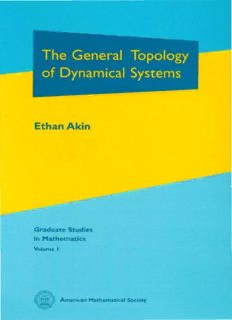
The General Topology of Dynamical Systems PDF
Preview The General Topology of Dynamical Systems
The General Topology of Dynamical Systems The General Topology of Dynamical Systems Ethan Akin Graduate Studies in Mathematics Volume I i>. _ ;: . American Mathematical Society . .,..· EDITORIAL BOARD Ronald R. Coifman William Fulton Lance W. Small 1991 Mathematics Subject Classification. Primary 58Fxx; Secondary 34Cxx, 34Dxx. ABSTRACT. Recent work in smooth dynamical systems theory has highlighted certain topics from topological dynamics. This book organizes these ideas to provide the topological foundations for dynamical systems theory in general. The central theme is the importance of chain recurrence. The theory of attractors and different notions of recurrence and transitivity arise naturally as do various Lyapunov function constructions. The results are applied to the study of invariant measures and topological hyperbolicity. Library of Congress Cataloging-in-Publication Data Akin, Ethan, 1946- The general topology of dynamical systems/Ethan Akin. p. cm.-(Graduate studies in mathematics, ISSN 1065-7339; v. 1.) Includes bibliographical references and index. ISBN 0-8218-3800-8 hardcover (alk. paper) I. Differentiable dynamical systems. 2. Topological dynamics. I. Title. II. Series. QA614.8.A39 1993 92-41669 5151.35-dc20 CIP Copying and reprinting. Individual readers of this publication, and nonprofit libraries acting for them, are permitted to make fair use of the material, such as to copy an article for use in teaching or research. Permission is granted to quote brief passages from this publication in reviews, provided the customary acknowledgment of the source is given. Republication, systematic copying, or multiple reproduction of any material in this publi cation (including abstracts) is permitted only under license from the American Mathematical Society. Requests for such permission should be addressed to the Manager of Editorial Services, American Mathematical Society, P.O. Box 6248, Providence, Rhode Island 02940-6248. The owner consents to copying beyond that permitted by Sections 107 or 108 of the U.S. Copyright Law, provided that a fee of $1.00 plus $.25 per page for each copy be paid directly to the Copyright Clearance Center, Inc., 27 Congress Street, Salem, Massachusetts 01970. When paying this fee please use the code 1065-7339/93 to refer to this publication. This consent does not extend to other kinds of copying, such as copying for general distribution, for advertising or promotional purposes, for creating new collective works, or for resale. Copyright @ 1993 by the American Mathematical Society. All rights reserved. The American Mathematical Society retains all rights except those granted to the United States Government. Printed in the United States of America. The paper used in this book is acid-free and falls within the guidelines established to ensure permanence and durability. § This publication was typeset using A.MS-TEX, the American Mathematical Society's TEX macro system. 10 9 8 7 6 54 3 2 I 98 97 96 95 94 93 For Paul Akin May 30, 1908 - May 26, 1992 Contents Preface ix 0. Introduction: Gradient Systems 1. Closed Relations and Their Dynamic Extensions 5 2. Invariant Sets and Lyapunov Functions 25 3. Attractors and Basic Sets 41 4. Mappings-Invariant Subsets and Transitivity Concepts 59 5. Computation of the Chain Recurrent Set 79 6. Chain Recurrence and Lyapunov Functions for Flows 103 7. Topologically Robust Properties of Dynamical Systems 123 8. Invariant Measures for Mappings 153 9. Examples-Circles, Simplex, and Symbols 179 I 0. Fixed Points 199 II. Hyperbolic Sets and Axiom A Homeomorphisms 221 Historical Remarks 253 References 255 Subject Index 259 VII Preface A large branch of modern dynamical systems theory has grown out of the work of Smale and his colleagues. The germinal technical concept, hyperbol icity, extended from a fixed point to more general invariant sets, consists of conditions imposed upon the tangent maps of the system. However, devel opment of the subject revealed the fruitfulness of a number of purely topo logical concepts such as attractor, basic set, filtration, and chain recurrence. While some of these ideas were new, many were familiar objects of study in topological dynamics. The latter was a well established subject, flourishing, and somewhat separated from the differentiable theory. However, perusal of surveys like Bhatia and Szego ( 1970) and Nemytskii and Stepanov ( 1960) reveals that topological dynamics drew much of its motivation, as well as many of its examples, from the still older qualitative theory of differential equations originating with Poincare and exemplified in Andronov, Vitt, and Khaikin's great book ( 1937). The recent global results associated with hyperbolicity have provided a new perspective on topological dynamics. For me this new view began with a look at Shub and Smale's 1972 paper, Beyond hyperbolicity. This book is the result of an often interrupted contemplation of the best way to organize the parts of topological dynamics which are most useful for the nonspecialist. John Kelley wrote in the preface to his justly famous book, General topology, that he was, with difficulty, prevented by his friends from using the title "What every young analyst should know". The reader will note that I have adapted his title. This is partly gratitude (and an attempt at sympathetic magic), but mostly because my intent is inspired by his. I hope to have described what every dynamicist should know, or at least be acquainted with, from topological dynamics. While the book is thus intended as a service text and reference, its sub ject eventually organized itself into a unified story whose central theme is the role of chain recurrence in the study of dynamical systems on compact metric spaces. The assumption of metrizability is, for most of the results, just a convenience, but compactness is essential. We repeatedly use the ix
Description: